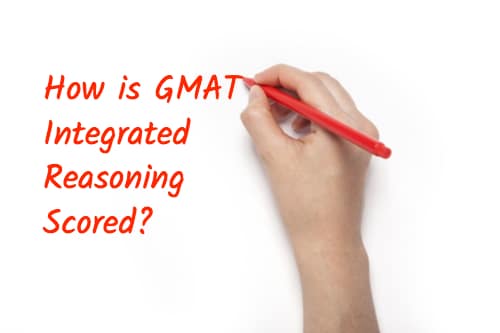
Many students have questions about the GMAT Integrated Reasoning (IR) section. “Is integrated reasoning part of the GMAT score?” Well…yes and no. Your IR score will be submitted to schools along with your verbal and quantitative score. However, the IR score is totally separate from the “total score,” which consists solely of the Q & V sections. But nonetheless, admission committees have started giving considerable attention to integrated reasoning GMAT scores, so it’s important to perform well on each section. Continue reading below for specifics on precisely how the IR section scored.
Overview of the GMAT’s Integrated Reasoning Section
Fact: The current version of the GMAT features a Verbal Section, a Quantitative Section, a single AWA essay, and the new Integrated Reasoning (IR) section. The sequence of the new test will be:
1) AWA essay = Analysis of Argument, 30 minutes
2) IR section = 12 questions, 30 minutes
3) optional break, up to 5 minutes
4) Q section = 31 questions, 62 minutes
5) optional break, up to 5 minutes
6) V section = 36 questions, 65 minutes
This the traditional order. As of July 11, 2017, this is one of three possible orders of the sections: students now have some choice about section order.
Fact: the IR section consists of four question types —
a) Graphics Interpretation (GI)
b) Two-Part Analysis (2PA)
c) Table Analysis (TA)
d) Multi-Source Reasoning (MSR)
Fact: all four question types will appear on everyone’s IR sections.
Fact: the breakdown by question type will differ from one person’s IR section to another person’s only because of the experimental questions.
In other words, everyone will have the same breakdown by question type for the questions that actually count toward their score. However, extra experimental questions are added in to this baseline, resulting in different IR section breakdowns for different people.
GMAC has revealed neither what that fundamental breakdown is nor how many of the 12 questions will be experimental. Let’s examine a hypothetical scenario just to understand:
Let’s say the graded IR questions consist of 2 GIs, 2 2PAs, 2 TAs, and 2 MSRs, for a total of eight (these are my made-up numbers). For everyone taking the test, let’s say those are the eight questions that are graded. The other four questions would be experimental questions, and will be different for different users. Thus, Abe might get an IR section with 3 GIs, 3 2PAs, 3 TAs, and 3 MSRs. Betsy might get an IR section with 2 GIs, 3 2PAs, 3 TAs, and 4 MSRs. Cathy might get an IR section with 2 GIs, 6 2PAs, 2 TAs, and 2 MSRs.
In each case, only the baseline eight questions count toward the score, and the others are experiments. (The numbers in this example are purely speculative: we have no idea what GMAC has up their sleeve.)
Here’s the kicker, though. As our hypothetical friend Cathy is working through her IR section, she may start to think: “Gee, I’m seeing a lot of 2PA questions! Some of them must be experimental!” Quite true. But the catch is, among those six 2 PA questions, the two that actually count could be the first two, or the last two, or any combination. Those comfortable with combinations will see that there are actually 6C2 = 15 different ways that the two that count could be scrambled among the four experimental questions.
As the test taker, even if you do have strong suspicions about which question types the experimental questions were, you will have no way of knowing, as you are working on a particular question, whether it counts or is experimental. Therefore, you have to treat every single question as if it counts, same as on the Q & V sections.
What determines the Integrated Reasoning GMAT Score?
Fact: the IR section is not computer adaptive. You are randomly assigned 12 questions as a group, and move through that sequence regardless of whether you are getting questions right or wrong.
Fact: The GMAT score report will consist of (a) V score, (b) Q score, (c) Total Score (combination of your V & Q scores), (d) AWA score, and (e) IR score.
Fact: the IR score will be an integer from 1 to 8. There is no partial credit on the IR section. For example, in a TA question in which there are three dichotomous prompts (e.g. true/false), you must get all three right to get credit for that one question. If you get at least one of the three parts wrong, the whole question is marked wrong.
Fact: The number of IR questions you get right will constitute a raw score. The GMAC, using some arcane alchemy known only to them, will convert that raw score into a scaled score (1 – 8), which will be accompanied by percentiles.
Notice: Because of the statistical magic GMAC uses in converting raw scores to scaled scores (on IR, Q, & V sections), what may seem to your advantage or disadvantage may not work out that way. For example, the fact that there’s no partial credit is challenging: it makes it harder to earn points on individual questions. BUT, harder for everyone means that lower raw scores are needed to get a higher percentile grade. By contrast, if all the questions are very easy, that means most people will get them right, which means it will be “crowded” at the top, and much harder to place in a high percentile. Therefore, what matters is not how inherently easy or hard the test is—what matters is how well you perform, compared to other test takers.
Given your inherent talents, what will maximize your GMAT skills with respect to others taking the GMAT? Sign up for Magoosh, and you will learn all the content and strategy you will need.
Editor’s Note: This post was originally published in May 2012 and has been updated for freshness, accuracy, and comprehensiveness.






Leave a Reply